We’ve all been there – staring at that dim corner of our garden or that north-facing windowsill wondering what could possibly thrive in such low-light conditions. The good news? There’s an incredible industry of shade-loving plants just waiting to transform your darkest spaces into lush green sanctuaries.
Contrary to popular belief shade doesn’t mean boring or limited plant choices. From vibrant hostas with their stunning foliage patterns to delicate ferns that create magical woodland vibes these plants have evolved to flourish where others can’t. They’re not just surviving in shade – they’re absolutely thriving and often producing more interesting textures and colors than their sun-loving counterparts.
Whether you’re dealing with dense tree cover deep indoor spaces or challenging architectural shadows we’ll show you how to turn these perceived limitations into your garden’s greatest assets. Get ready to discover plants that’ll make you fall in love with shade all over again.
Understanding Shade Gardens and Their Benefits
Shade gardening opens up countless possibilities for creating stunning landscapes in areas where traditional sun-loving plants struggle. We’ll explore how different shade conditions affect plant growth and discover the unique advantages these environments offer.
What Constitutes Shade in Gardening
Partial shade receives 2-6 hours of direct sunlight daily, typically during morning or late afternoon hours. Gardens under deciduous trees or on the east side of buildings often fall into this category. Many flowering plants like astilbe and coral bells thrive in these conditions.
Full shade areas get less than 2 hours of direct sunlight per day but still receive bright, indirect light. North-facing garden beds and spaces under dense tree canopies create these conditions. Plants like hostas and ferns flourish in full shade environments.
Deep shade represents the most challenging condition, where areas receive no direct sunlight and minimal indirect light. Spaces under evergreen trees or between tall buildings typically experience deep shade. Only the most shade-tolerant plants like pachysandra and certain mosses can survive here.
Dappled shade occurs when sunlight filters through moving tree branches, creating a constantly changing pattern of light and shadow. This ever-changing environment suits many woodland plants that have adapted to fluctuating light conditions throughout the day.
Advantages of Growing Plants That Like Shade
Reduced watering requirements make shade gardens more sustainable and cost-effective to maintain. Shade plants typically lose less moisture through transpiration compared to their sun-loving counterparts. We’ve found that most shade gardens require 30-50% less water than full-sun gardens.
Extended growing seasons benefit from cooler soil temperatures that shade provides. Plants in shaded areas often continue growing well into summer when sun plants become stressed. Many shade perennials like lungwort and bleeding heart extend their blooming period in cooler conditions.
Lower maintenance needs characterize most shade garden plants since they’re naturally adapted to slower growth rates. Weeds also grow more slowly in shaded areas, reducing the need for frequent cultivation. Mulch lasts longer in shade gardens because it doesn’t break down as quickly in cooler conditions.
Energy efficiency improves around homes when we strategically place shade gardens near foundations and air conditioning units. These plantings can reduce cooling costs by up to 25% during hot summer months.
Common Challenges in Shade Gardening
Soil compaction frequently occurs in shaded areas, especially under large trees where foot traffic is common. Tree roots also compete with garden plants for nutrients and water. We recommend adding organic matter annually to improve soil structure and drainage.
Limited plant selection can frustrate gardeners who want colorful blooms throughout the season. Many popular flowering annuals require full sun and won’t perform well in shade. But, focusing on foliage plants creates year-round interest through varied textures and colors.
Pest and disease issues often increase in shaded, humid environments where air circulation is poor. Fungal problems like powdery mildew and leaf spot diseases commonly affect shade plants. Proper spacing and selecting disease-resistant varieties help minimize these issues.
Slow establishment characterizes many shade plants, which can test gardeners’ patience during the first growing season. Root development takes longer in cooler soil conditions, and plants may appear dormant for extended periods. Understanding that shade plants invest energy in root systems before top growth helps set realistic expectations.
Hostas: The Classic Shade Garden Staple
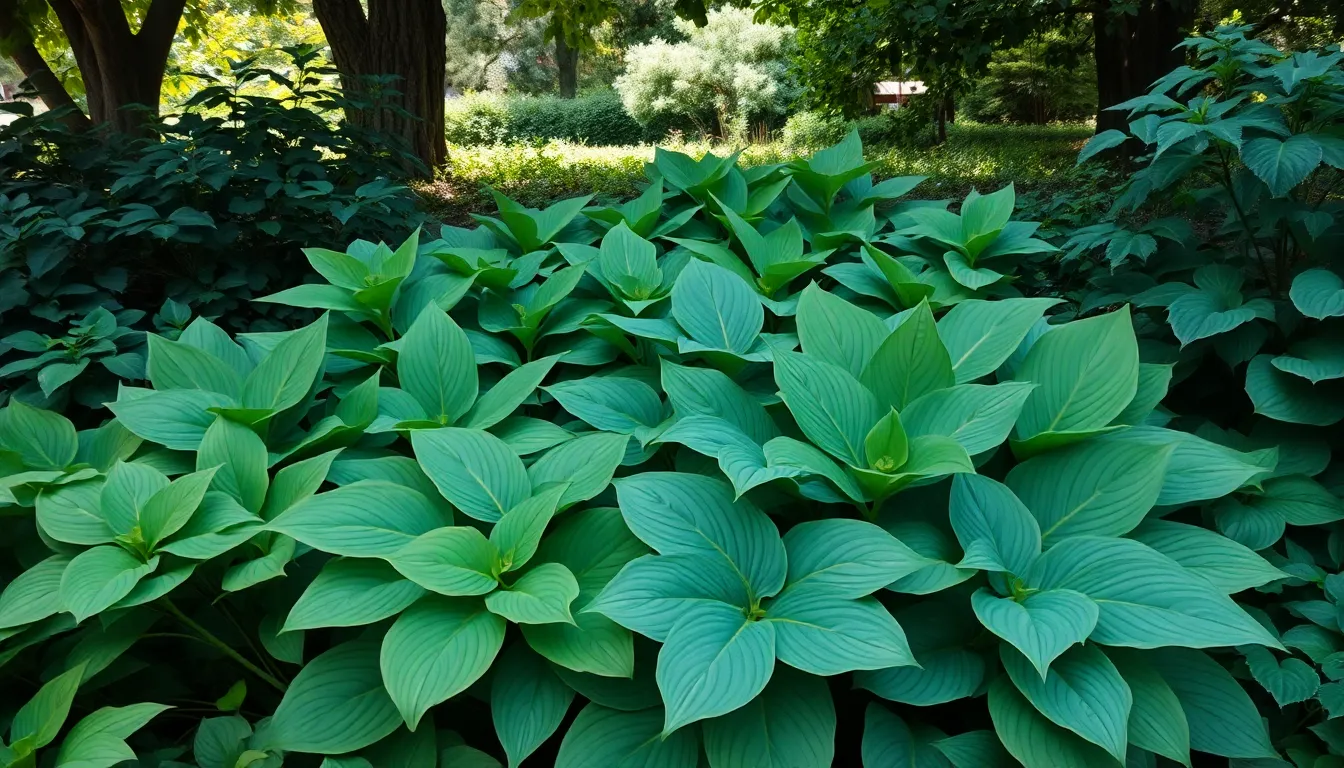
Hostas stand as the quintessential choice for shade gardens, offering lush foliage and unmatched versatility in low-light environments. We consider them among the most popular shade-loving perennials because they thrive where many other plants struggle to survive.
Varieties and Foliage Patterns
Foliage diversity makes hostas incredibly appealing for shade garden design. We find their leaves display remarkable variation in shape, size, and color patterns that create visual interest throughout the growing season.
Solid colored varieties showcase pure green, blue-green, or yellow tones that provide consistent backdrop plantings. Blue-green hostas like ‘Blue Angel’ create cool, calming effects in deeply shaded areas.
Variegated options feature striking white, cream, or yellow edges or centers that brighten dark garden corners. We recommend varieties with white margins for maximum light reflection in shady spots.
Textural differences range from smooth glossy surfaces to heavily corrugated leaves that add dimensional interest. Corrugated varieties like ‘Sum and Substance’ create dramatic shadow patterns even in low light conditions.
Size categories span from miniature varieties perfect for containers or borders to large-leaved specimens that make bold industry statements. Miniature hostas work well in small spaces, while giant varieties can anchor entire shade garden designs.
Care Requirements and Growing Tips
Light preferences favor partial to full shade conditions for optimal hosta health. We’ve observed that some varieties tolerate morning sun exposure, but excessive direct sunlight scorches their delicate leaves.
Soil composition should be rich, well-drained, and moisture-retentive with organic matter amendments. Adding compost or aged manure improves soil structure and provides essential nutrients for vigorous growth.
Watering consistency proves crucial, especially during dry spells when hostas show stress quickly. We maintain steady moisture levels without creating waterlogged conditions that promote root rot.
Mulching applications help retain soil moisture while preventing weed competition around hosta crowns. Organic mulches like shredded bark or compost also decompose to enrich the soil over time.
Pest management focuses primarily on slug and deer control, as these commonly damage hosta foliage. We use beer traps for slugs and deer-resistant companion plantings to protect our hosta investments.
Winter care requires minimal effort since hostas naturally die back to ground level in winter. New growth emerges reliably each spring, making them dependable perennial performers in shade gardens.
Ferns: Ancient Beauties for Modern Shade Gardens
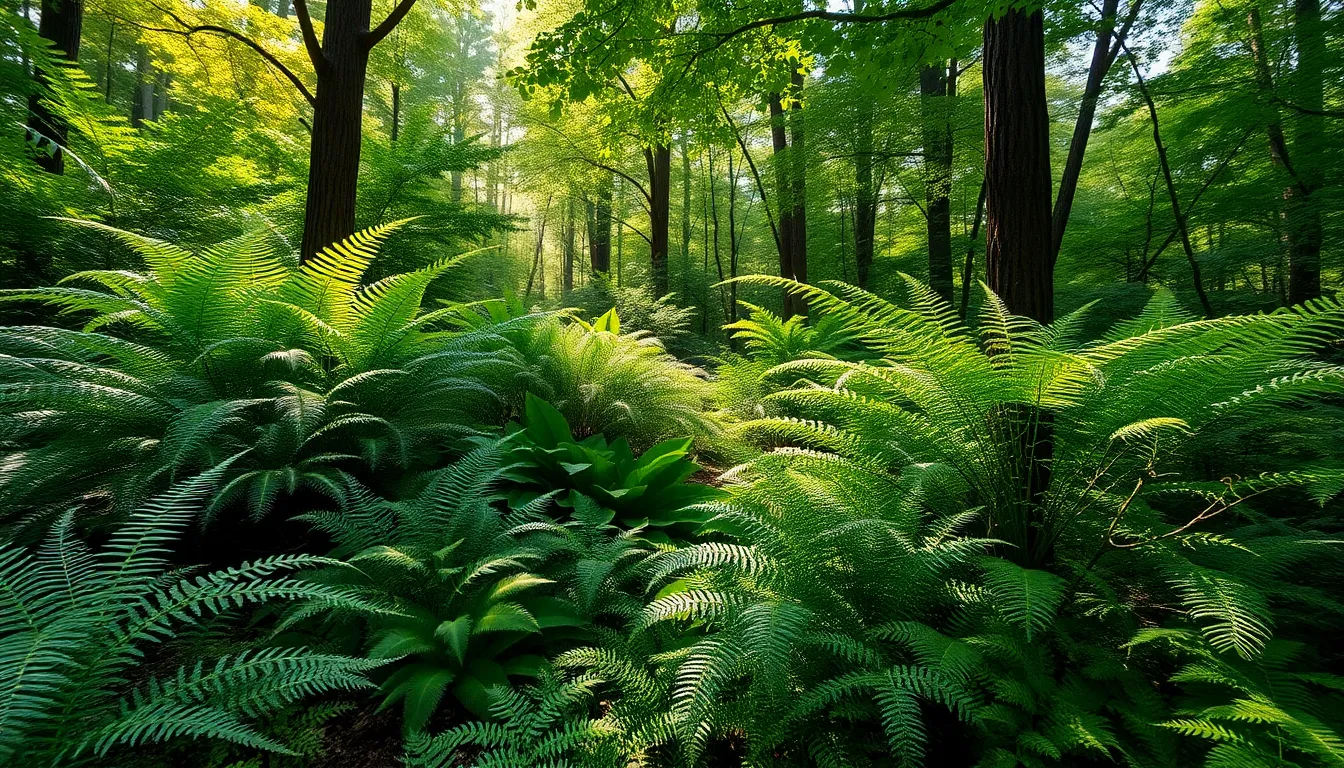
Ferns bring timeless elegance to shade gardens with their graceful fronds and lush textures that complement the hostas we’ve already explored. These ancient plants have mastered the art of thriving in low light conditions, making them perfect companions for creating sophisticated shade landscapes.
Popular Fern Species for Shade
Maidenhair Fern stands out as our top recommendation for delicate beauty in shaded spaces. This graceful species (Adiantum pedatum) displays airy, lace-like fronds that dance with the slightest breeze, creating movement and visual interest in static shade areas. We’ve found it thrives in consistently moist, well-drained soil under dappled shade conditions.
Lady Ferns offer reliable performance in various shade conditions throughout our gardens. These versatile plants adapt well to different moisture levels and provide sturdy, upright growth that fills middle-tier planting areas effectively.
Christmas Ferns deliver year-round structure with their evergreen fronds that remain attractive even through winter months. We particularly value these hardy specimens for their ability to maintain garden interest when other shade plants have died back.
Creating Natural Woodland Aesthetics
Forest understory environments serve as our inspiration for developing authentic woodland shade gardens. Native ferns naturally complement other woodland plants like White Dolls Eyes (Actaea pachypoda) and Wild Leek (Allium tricoccum), creating layered plantings that mirror natural forest floors.
Allegheny Serviceberry (Amelanchier laevis) adds seasonal flowers and fruits that enhance our fern plantings with vertical structure and wildlife value. This combination creates depth and provides food sources for local birds and pollinators.
Natural mulch management becomes easier when we allow tree leaf litter to remain around our fern plantings. These plants have evolved to thrive under this organic layer, reducing our maintenance requirements while supporting the natural network processes that keep woodland gardens healthy.
Layered planting schemes work best when we combine ferns with grasses, sedges, and native flowering plants at different heights. This approach recreates the complex plant communities we observe in natural forest settings, resulting in more resilient and visually appealing shade gardens.
Astilbe: Colorful Blooms That Thrive in Shade
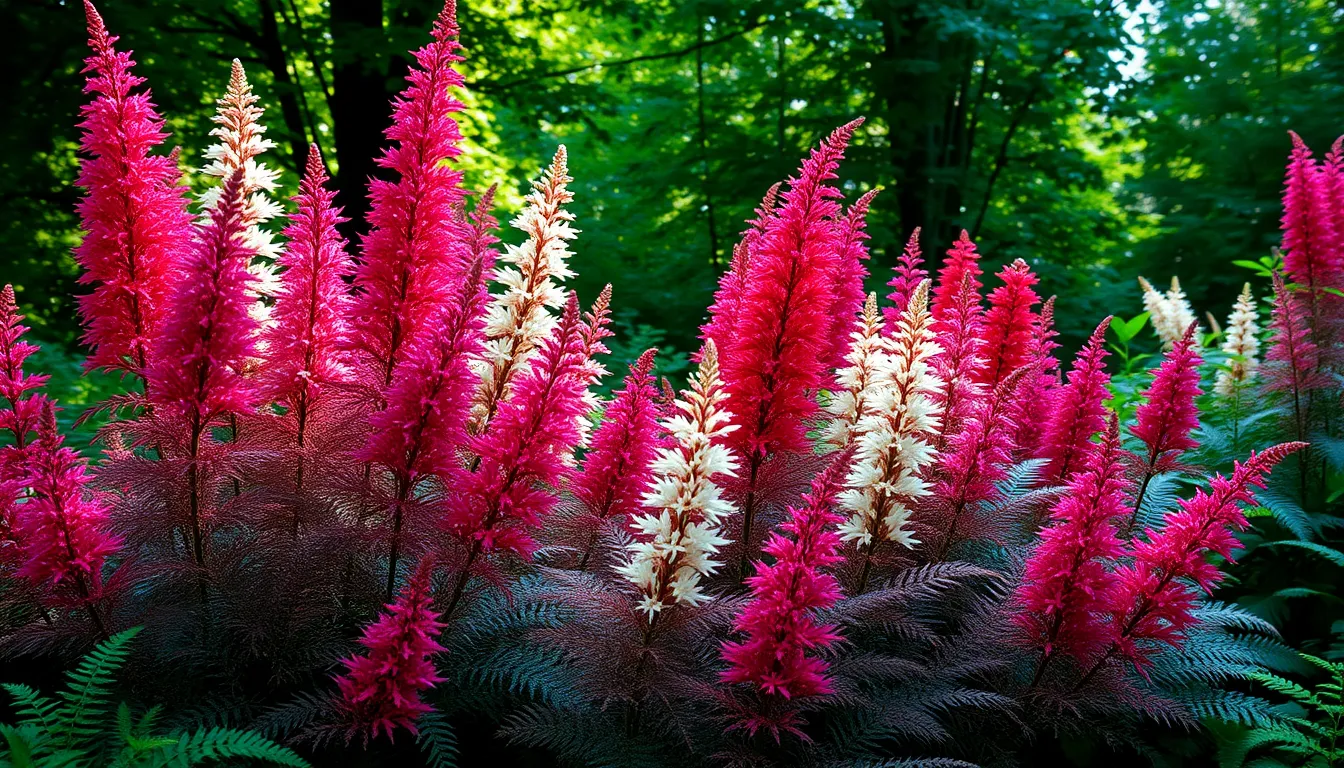
Astilbe stands out as a premier choice for shade gardens, offering vibrant blooms that flourish in partial shade conditions. This perennial creates stunning displays that bridge the gap between spring bulbs and late summer perennials.
Flower Colors and Seasonal Display
Summer transforms astilbe plants into spectacular focal points with their distinctive plume-like flower spikes. These feathery blooms emerge in an impressive array of colors including pink, red, white, and violet variations that brighten even the darkest garden corners. Rising above the plant’s finely divided, ferny foliage, these colorful plumes create striking visual contrast that enhances any shaded industry design.
Blooming typically occurs during mid to late summer when many other shade plants have finished their flowering cycle. The flowers maintain their beauty for several weeks, providing extended color in areas where direct sunlight is limited. Astilbe’s ability to produce such vibrant displays in partial to full shade makes it invaluable for gardeners seeking reliable summer color in challenging growing conditions.
Planting and Maintenance Guidelines
Establishing astilbe successfully requires attention to exact soil and moisture conditions that support optimal growth. These plants perform best in moist, well-drained soil that’s rich in organic matter, thriving in USDA zones 4-8 where temperatures remain moderate. Partial shade provides ideal growing conditions, though astilbe can adapt to full shade or limited sun exposure with proper care.
Regular watering becomes essential during dry periods to maintain consistently moist soil conditions around the root zone. Mulching around plants helps retain soil moisture while keeping roots cool during warmer months. Division every few years rejuvenates established clumps and maintains vigorous flowering, typically performed in early spring or fall when plants are dormant.
Growing astilbe plants typically reach heights of 1 to 4 feet with similar spread measurements, making them excellent for creating layered plantings in shade gardens. Their low maintenance requirements and reliable performance make them ideal companions for hostas and ferns in woodland garden settings.
Caladium: Tropical Foliage Plants That Like Shade
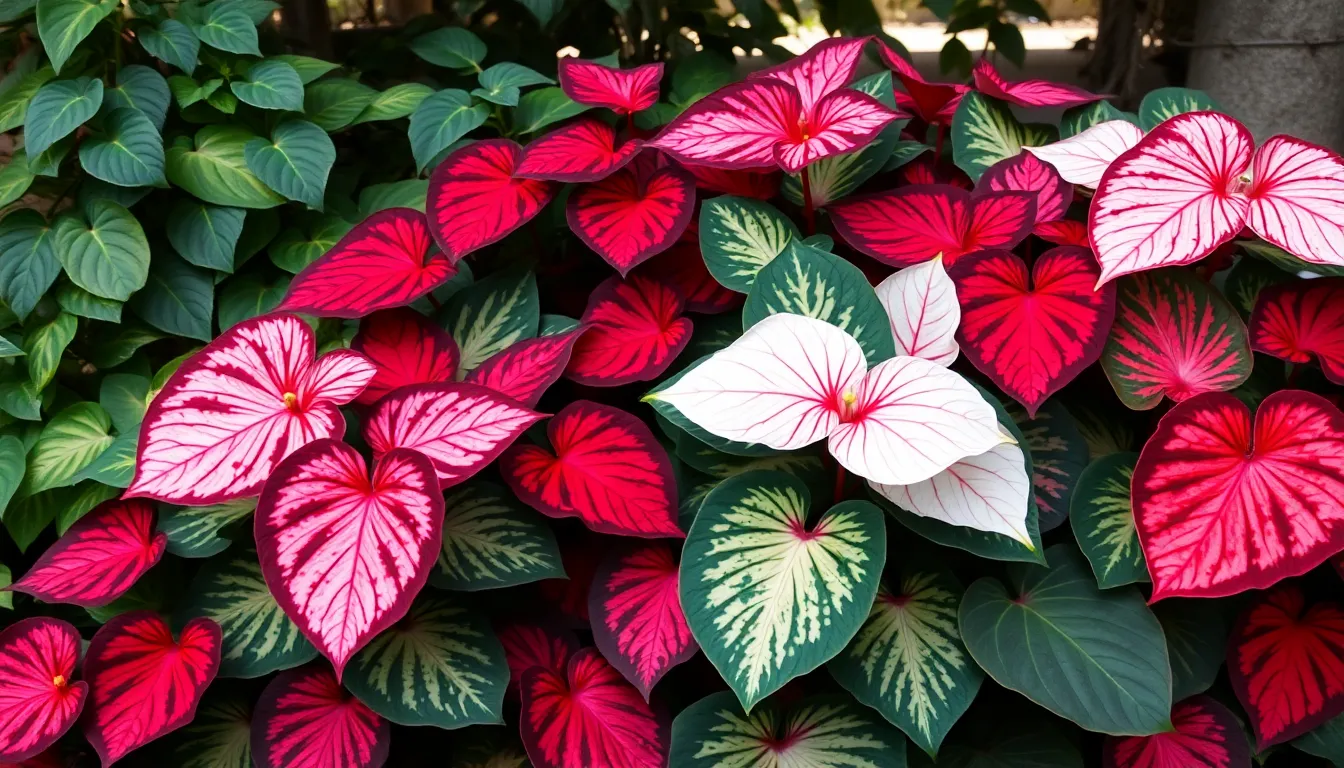
Caladiums bring tropical flair to our shade gardens with their stunning foliage that outshines many flowering plants. We love how these versatile perennials thrive in the same low-light conditions where hostas, ferns, and astilbe flourish.
Heart-Shaped Leaves and Color Variations
Heart-shaped leaves define caladiums and create striking visual interest in our shaded spaces. These distinctive leaves showcase vibrant color combinations that include red, pink, white, and green variations. We find these tropical foliage plants particularly effective at brightening dim corners where other colorful options struggle.
Vivid leaf colors remain intense when caladiums receive proper indirect light rather than harsh sun exposure. Pink varieties offer soft, romantic tones that complement astilbe’s delicate blooms. Red caladiums provide bold contrast against the green backdrop of hostas and ferns. White patterns create elegant highlights that reflect available light back into darker garden areas.
Color combinations within individual leaves add complexity to our shade garden designs. We appreciate how variegated caladiums display multiple hues in beautiful patterns across each heart-shaped leaf. Green margins often frame colorful centers, while some varieties feature intricate veining that creates natural artwork in our plantings.
Indoor and Outdoor Growing Options
Outdoor planting works best in shaded garden beds or containers where caladiums receive filtered light. We position them alongside other shade lovers like begonias, coleus, and impatiens to create layered tropical displays. These plants excel in warm temperatures and high humidity conditions similar to their native environments.
Container growing offers flexibility for moving caladiums to optimal locations throughout the growing season. We use this method to create portable tropical accents on patios or decks with limited direct sunlight. Large containers also allow us to control soil moisture more effectively than ground plantings.
Indoor cultivation transforms caladiums into stunning houseplants when we place them away from direct sunlight. These tropical specimens thrive near north-facing windows or in rooms with bright, indirect light. We maintain higher humidity levels around indoor caladiums using pebble trays or room humidifiers.
Seasonal flexibility allows us to enjoy caladiums year-round by moving container plants indoors before temperatures drop. This practice extends their growing season and protects these tropical plants from cold damage. We find this particularly valuable in regions with shorter growing seasons.
Heuchera: Coral Bells for Year-Round Interest
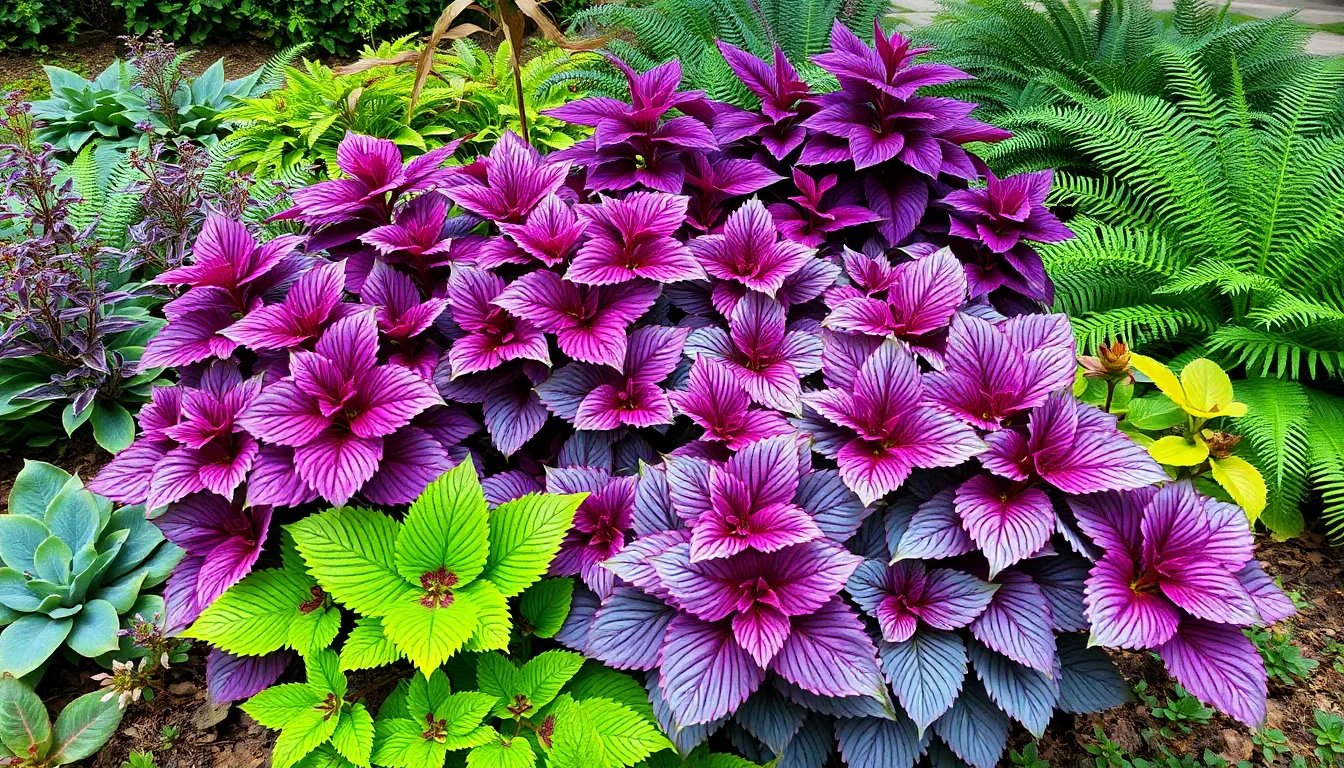
Heuchera stands out as one of our most versatile shade perennials, offering continuous visual appeal even when flowers aren’t present. These remarkable plants have earned their place in shade gardens through their stunning foliage variations and reliable performance.
Foliage Colors and Textures
Coral Bells showcase an impressive spectrum of leaf colors that brighten even the darkest garden corners. Deep purples create dramatic contrast against lighter companions, while vibrant greens provide fresh backdrops for more colorful plantings. Silver toned varieties reflect available light to illuminate shaded spaces naturally.
Texture variations make Heuchera particularly valuable for creating visual interest throughout the seasons. Smooth leaves offer clean lines that complement busier foliage patterns, while ruffled varieties add movement and dimension to planting schemes. Slightly hairy leaf surfaces create subtle texture contrasts that become more apparent as light filters through the canopy.
These foliage characteristics remain attractive from spring through fall, making Coral Bells essential for maintaining garden interest when seasonal bloomers fade. Color intensity often deepens in cooler weather, providing unexpected autumn highlights in shade gardens.
Companion Planting Strategies
Successful Heuchera combinations start with plants sharing similar shade and moisture preferences. Ferns create perfect partnerships by contributing feathery textures that contrast beautifully with Coral Bells’ broad leaves. Hostas bring their own bold foliage shapes to complement Heuchera’s more delicate forms.
Astilbes enhance summer displays with their showy plumes in pink, red, white, or violet colors that bloom above Coral Bells’ foliage. These moisture-loving perennials thrive in the same rich, well-draining soil conditions that support healthy Heuchera growth.
Spring additions like early bulbs or wild leeks extend seasonal interest before Coral Bells reach their peak foliage development. Native options such as Maidenhair Fern and White Dolls Eyes create authentic woodland aesthetics while supporting local ecosystems.
Begonias offer continuous summer color from early season to frost, thriving in the same partial shade conditions that suit Heuchera perfectly. Container combinations work especially well for seasonal flexibility and accent plantings in shaded areas.
Begonias: Flowering Plants That Like Shade

Begonias stand out as exceptional flowering plants that thrive in shaded environments, offering vibrant blooms when many other flowers struggle in low light conditions. These versatile plants bring continuous color to areas that receive partial to full shade, making them perfect additions to our shade gardening repertoire.
Wax Begonias vs. Tuberous Varieties
Wax begonias feature glossy leaves and produce small, continuous blooms throughout warm months in colors including pink, white, red, and orange. These hardy plants tolerate some sun exposure but perform optimally in partial shade conditions. Border plantings and container displays benefit greatly from wax begonias’ reliable flowering habit and compact growth pattern.
Tuberous begonias showcase large, showy blooms that create dramatic focal points in shaded garden spaces. Consistently moist, well-drained soil supports their growth requirements, while partial to full shade locations provide ideal growing conditions. Striking flower shapes and bold colors make tuberous varieties particularly effective for brightening dim garden beds and container arrangements.
Performance differences between these varieties make each suitable for exact shade gardening applications. Wax types offer durability and continuous blooms for everyday garden use, while tuberous varieties provide statement pieces for special garden displays.
Container Gardening Applications
Patio and porch displays benefit tremendously from begonias’ shade tolerance, creating vibrant color where traditional sun-loving flowers fail to thrive. Containers allow us to position these plants in optimal shade locations and adjust their placement as seasonal light patterns change. Indoor placements near windows with indirect light extend our growing options beyond outdoor spaces.
Moisture retention containers work best for begonia cultivation, though proper drainage prevents root rot issues that plague poorly planned plantings. Moving containers to ideal shade positions throughout growing seasons maximizes bloom production and plant health. Strategic placement creates stunning displays in areas where ground plantings might struggle with challenging shade conditions.
Versatile design options emerge when we combine begonias with other shade-loving plants like hostas, ferns, and coral bells in mixed container arrangements. Layered plantings using different begonia varieties add depth and visual interest to shaded spaces. Container mobility allows us to experiment with various combinations and seasonal arrangements throughout the growing year.
Impatiens: Continuous Blooms in Shaded Areas
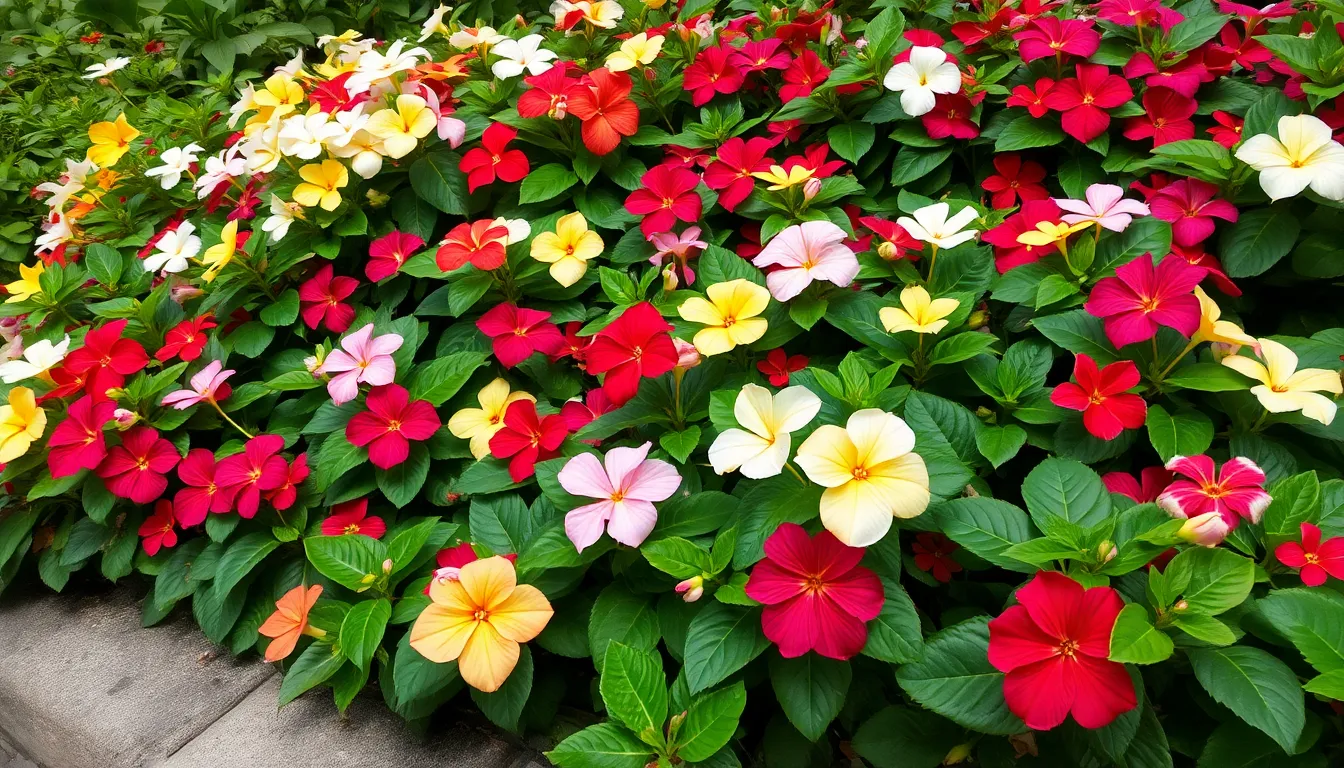
Impatiens stand out as exceptional performers in shade gardens, delivering nonstop blooms throughout the growing season when many other flowers struggle in low light conditions. These versatile annuals brighten even the darkest corners of our gardens with their cheerful colors and reliable flowering habits.
New Guinea vs. Standard Impatiens
Standard Impatiens (Impatiens walleriana) represent the classic choice for deep shade locations, offering an impressive array of flower colors and shapes that we’ve relied on for decades. These traditional varieties thrive in heavily shaded areas where other plants fail to bloom, making them indispensable for challenging garden spots.
New Guinea Impatiens (Impatiens hawkeri) bring enhanced versatility to our shade gardens with their ability to tolerate partial sun conditions alongside traditional shade preferences. Larger flowers distinguish these newer hybrids from their standard counterparts, creating more dramatic visual impact in our plantings. Stronger stems support the vigorous growth habit that makes New Guinea varieties particularly robust choices for containers and borders.
Enhanced durability sets New Guinea Impatiens apart, especially their superior resistance to diseases that commonly affect standard varieties. Better tolerance for varying light conditions means we can use these hybrids in transitional areas between full shade and partial sun, expanding our planting options significantly.
Disease Prevention and Care
Downy mildew poses the greatest threat to standard Impatiens, causing yellowing leaves, leaf drop, and eventual plant death that can devastate entire plantings. Prevention strategies focus on improving air circulation around plants and avoiding overhead watering that creates the moist conditions this fungal disease requires to spread.
Resistant varieties like New Guinea Impatiens offer our best defense against downy mildew while maintaining the continuous blooming we value in shade gardens. Alternative planting approaches include spacing plants appropriately and choosing well-draining locations that don’t retain excess moisture.
Proper cultural practices ensure healthy Impatiens throughout the growing season, starting with moist, well-draining soil enriched with organic matter. Regular watering maintains consistent soil moisture without creating waterlogged conditions that promote disease development. Deadheading spent flowers encourages continuous blooming while preventing energy waste on seed production.
Fertilizing every few weeks supports the vigorous growth and abundant flower production that makes Impatiens so valuable in our shade gardens. Avoiding harsh sun exposure protects plants from stress while maintaining the vibrant colors that brighten our shaded spaces effectively.
Japanese Painted Fern: Silvery Elegance for Shade
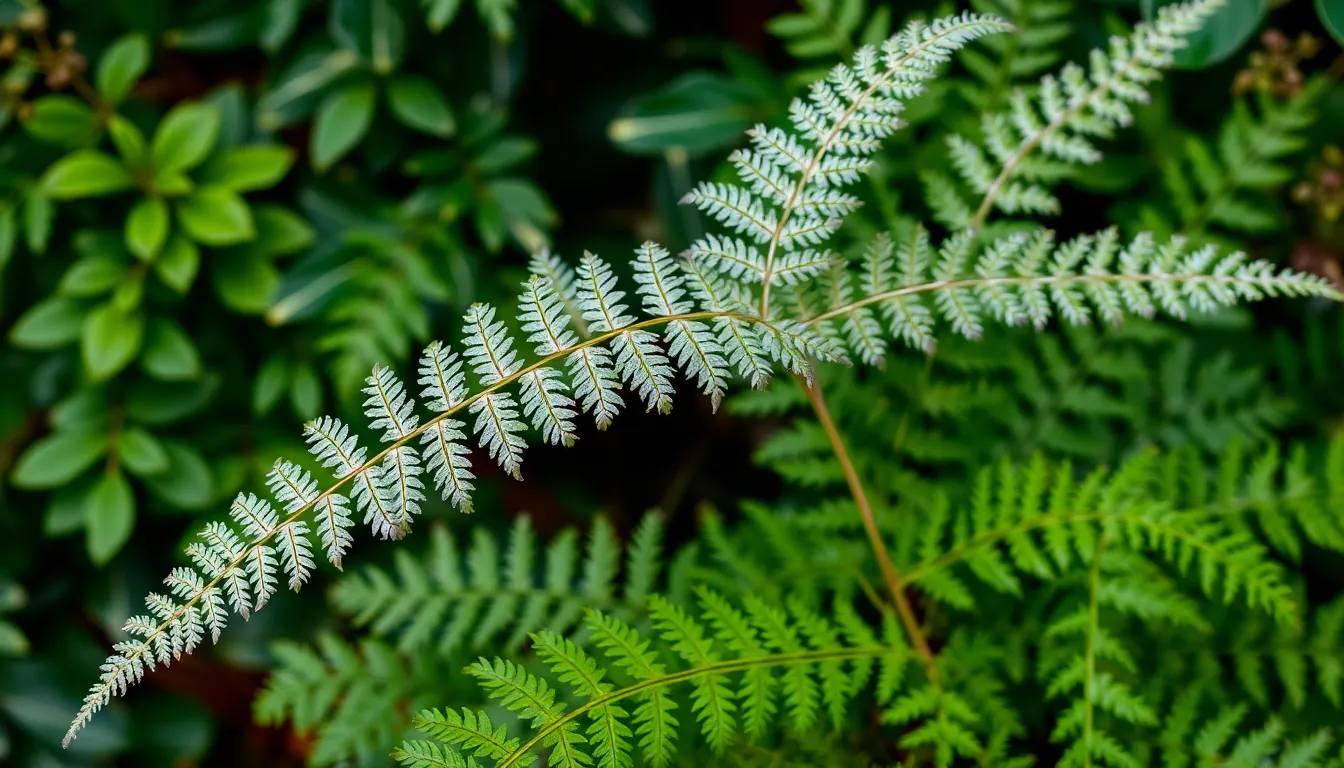
Among shade loving perennials, Japanese Painted Fern stands out with its distinctive metallic foliage that transforms dim garden spaces into luminous displays.
Distinctive Coloration and Growth Habits
Distinctive coloration makes Japanese Painted Fern a standout choice for shade gardens. The fern’s fronds display an elegant silvery sheen with accents of purple, green, and burgundy that create stunning visual contrast against typical shade garden plants. This metallic quality reflects available light in ways that brighten shadowy areas where most plants struggle to provide vibrant color.
Growth habits of Japanese Painted Fern are perfectly suited for shade garden design. These perennials reach 12 to 18 inches in height while spreading slowly to form dense, low mounds that serve as excellent groundcover. Their finely divided fronds create delicate texture that adds sophistication to woodland gardens, shaded borders, and foundation plantings.
Optimal growing conditions for Japanese Painted Fern include moist, well-drained soils and part to full shade. The plants thrive in areas with limited sunlight exposure, making them ideal companions for established shade gardens. Their moderate size and spreading habit allow them to fit seamlessly into existing industry designs without overwhelming neighboring plants.
Pairing with Other Shade Perennials
Pairing Japanese Painted Fern with complementary shade perennials creates ever-changing garden compositions. The fern’s silvery fronds serve as striking focal points that enhance the beauty of companion plants while providing textural contrast in layered plantings.
Hostas provide excellent backdrop plants for Japanese Painted Fern combinations. Their broad, lush leaves create solid green backgrounds that make the fern’s metallic coloration appear even more dramatic. This partnership works particularly well in woodland settings where different leaf textures create natural forest floor aesthetics.
Heuchera, or Coral Bells, harmonize beautifully with Japanese Painted Fern’s tonal qualities. The range of Heuchera leaf colors from deep purple to lime green complements the fern’s silvery purple accents, creating sophisticated color palettes that remain interesting throughout the growing season.
Astilbe adds vertical interest when planted alongside Japanese Painted Fern. The feathery plumes of Astilbe flowers contrast with the fern’s horizontal growth pattern, creating dimensional layering that enhances overall garden structure. This combination works especially well in partially shaded areas where both plants can thrive.
Other fern species can be combined with Japanese Painted Fern for naturalistic woodland effects. Mixing different fern varieties creates layered textures that mimic natural forest understory environments, providing diverse visual interest while maintaining cohesive garden themes.
Coleus: Vibrant Foliage Plants That Like Shade
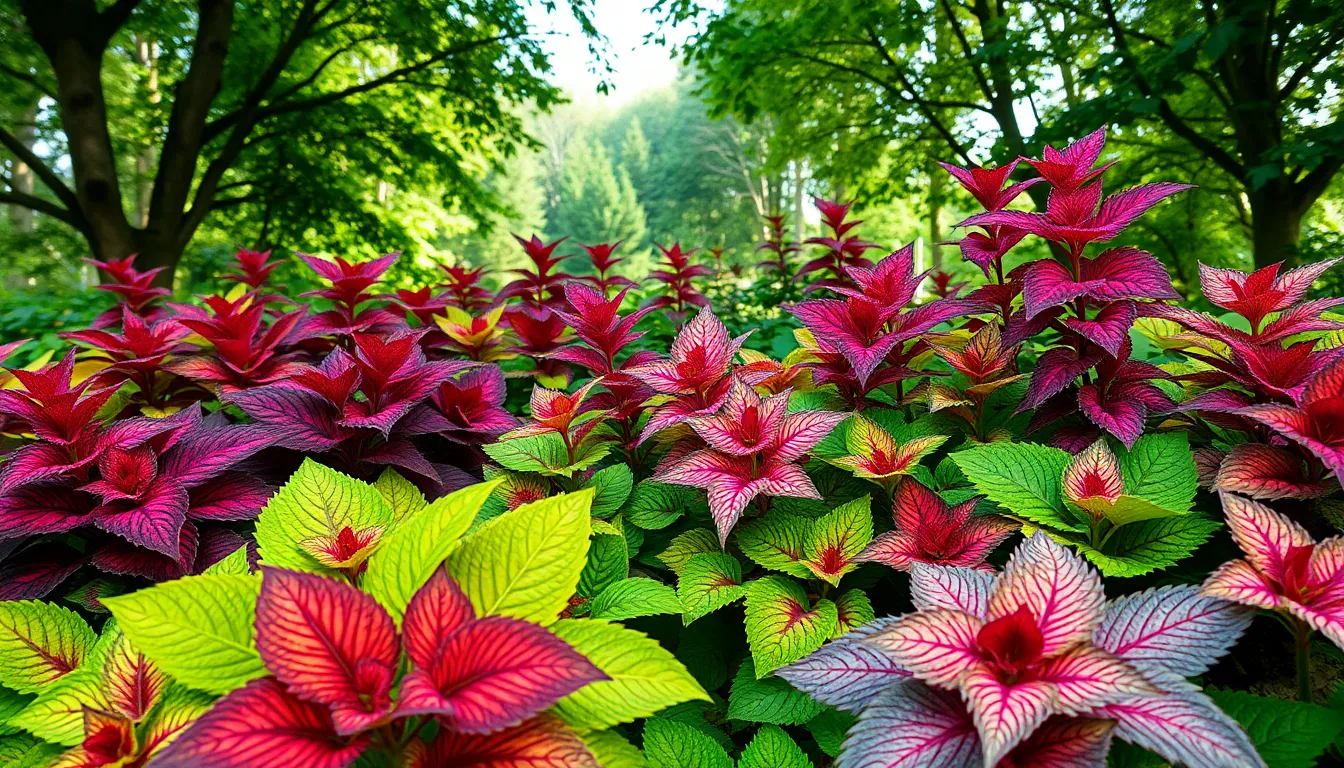
We’ve discovered that coleus stands out as one of the most rewarding plants for shade gardening, offering incredible visual impact through its stunning foliage rather than flowers. This versatile plant thrives in partial to full shade, making it perfect for those challenging spots where other colorful plants struggle.
Leaf Patterns and Color Combinations
Coleus leaves showcase an impressive spectrum of colors that can transform any shaded garden into a vibrant masterpiece. We’ll find shades of green, red, burgundy, purple, pink, yellow, and cream working together in striking combinations that rival any flowering display. The intricate patterns these plants create include solid color blocks, contrasting edges that frame each leaf, prominent veins that create natural artwork, and bold central stripes that add dramatic flair.
These remarkable color variations allow us to use coleus as living paint in our shade gardens. Different cultivars present unique combinations like deep burgundy centers with bright green edges, or cream colored leaves accented with pink and purple veins. The ornamental appeal these patterns provide brightens even the darkest corners of our outdoor spaces.
We can mix multiple coleus varieties to create stunning tapestries of color throughout our shaded areas. The variegated patterns ensure visual interest remains high even without blooms, giving us continuous beauty from spring through fall.
Pinching and Propagation Techniques
Regular pinching becomes essential for maintaining coleus plants at their bushiest and most attractive form. We need to pinch young shoots just above leaf nodes to encourage branching and prevent our plants from becoming tall and leggy. This simple technique promotes fuller foliage that creates better coverage in our shade gardens.
Growing new coleus plants from existing ones couldn’t be easier with basic propagation methods. We can cut 3 to 4 inch sections from healthy stems just below a node, then remove the lower leaves before placing cuttings in water or moist soil. Roots typically develop within 1 to 2 weeks, allowing us to multiply our favorite varieties quickly and affordably.
The straightforward nature of coleus propagation means we can expand our shade garden collection without additional costs. We’ll often find that friends and neighbors appreciate receiving rooted cuttings of our most beautiful coleus varieties. This easy multiplication process makes coleus an excellent choice for filling larger shaded areas or creating consistent color themes throughout our gardens.
Water propagation works particularly well during warmer months, while soil propagation gives us stronger root systems for transplanting. Both methods provide reliable results that help us create impressive displays of colorful foliage in our shade loving plant collections.
Conclusion
We’ve discovered that shade gardening opens up a industry of possibilities far beyond what many gardeners initially imagine. From the reliable elegance of hostas and ferns to the vibrant colors of coleus and caladiums these plants prove that limited sunlight doesn’t mean limited beauty.
The key to successful shade gardening lies in understanding your exact light conditions and choosing plants that’ll thrive rather than merely survive. Whether you’re working with deep shade or dappled light there’s a perfect combination of textures colors and forms waiting to transform your space.
We encourage you to experiment with layering different heights and foliage types to create depth and visual interest. Remember that shade gardens often require less water and maintenance than their sun-loving counterparts making them ideal for busy gardeners or challenging growing conditions.
Start small with a few proven performers and gradually expand your shade garden as you gain confidence and experience.
Frequently Asked Questions
What types of plants thrive in shade gardens?
Shade gardens support a diverse range of plants including hostas, ferns, astilbe, caladiums, heuchera (coral bells), begonias, impatiens, Japanese painted fern, and coleus. These plants offer vibrant foliage colors, interesting textures, and some provide beautiful blooms. Many shade plants actually display more intricate patterns and colors than their sun-loving counterparts, making shade areas perfect for creating lush, visually appealing gardens.
What are the different types of shade in gardening?
There are four main types of shade: partial shade (3-6 hours of sunlight), full shade (less than 3 hours of direct sunlight), deep shade (very little to no direct sunlight), and dappled shade (filtered light through tree canopies). Each type supports different plant varieties, and understanding your garden’s shade conditions helps you select the most suitable plants for optimal growth and appearance.
What are the benefits of shade gardening?
Shade gardening offers several advantages including reduced watering requirements since shade plants typically need less moisture, extended growing seasons with protection from harsh sun, and lower maintenance needs. Shade gardens also stay cooler in summer, reduce soil erosion, and many shade plants are naturally pest-resistant. Additionally, shade areas often have richer soil from decomposing organic matter.
How do I care for hostas in my shade garden?
Hostas require rich, well-drained soil with consistent moisture but not waterlogged conditions. Water regularly during dry periods and apply mulch to retain moisture. Watch for common pests like slugs and snails, using organic control methods when needed. Hostas need minimal winter care and will return reliably each spring. Divide clumps every 3-4 years to maintain vigor and create new plants.
Can I grow flowering plants in shade?
Yes, many beautiful flowering plants thrive in shade including astilbe with colorful plume-like blooms, begonias with continuous flowers, and impatiens that bloom throughout the growing season. These plants often extend the flowering period in shaded areas when sun plants have finished blooming, providing sustained color and interest in low-light conditions while requiring less maintenance than typical sun flowers.
How do I create a layered shade garden design?
Create depth by layering plants of different heights and textures. Use taller plants like large hostas or ferns as backdrops, medium-height plants like astilbe and heuchera in the middle, and shorter plants like begonias or small hostas in front. Combine different foliage colors and textures, and add natural mulch from leaf litter to mimic forest understory environments for a cohesive, natural appearance.
What’s the difference between wax and tuberous begonias?
Wax begonias have glossy leaves and produce continuous small blooms in various colors. They’re hardy, reliable, and perfect for everyday shade gardening use. Tuberous begonias feature large, dramatic flowers and are more striking as focal points but require more specific care. Both thrive in shade, but tuberous varieties are often grown in containers for easier management and seasonal protection.
How do I maintain coleus plants in shade gardens?
Maintain coleus by regularly pinching off flower buds to encourage bushier foliage growth, as the leaves are the main attraction. Provide consistent moisture and well-draining soil. Coleus is easy to propagate through cuttings, allowing you to expand your collection. Since coleus is typically grown as an annual, you can take cuttings indoors before frost to overwinter and replant the following season.
What challenges should I expect with shade gardening?
Common shade gardening challenges include soil compaction from tree roots, limited plant selection compared to sun gardens, potential pest and disease issues in humid conditions, and slower plant establishment. Some areas may have deep shade that limits options further. Address these by improving soil drainage, choosing appropriate plants for your specific shade conditions, and providing adequate air circulation to prevent moisture-related problems.
Can I use containers in shade gardens?
Container gardening works excellently in shade areas, offering flexibility to move plants for optimal light conditions and seasonal protection. This approach is particularly beneficial for tropical plants like caladiums and tuberous begonias that can be moved indoors during cold weather. Containers also help with drainage issues common in shaded areas and allow you to control soil quality more easily.







